Before getting started. Let's define what it means to create a content marketing strategy using inbound principles (or as I like to call it—inbound content strategy).
A successful inbound content strategy focuses on using content to attract, engage, and delight relevant website visitors by telling a compelling story that educates and inspires them to make a transformation — putting their interest and needs above your bottom line. The focus of an inbound content strategy is on transform; Yes, you want to teach them something, but doing that alone is not enough. To really help them transform you need to help them apply what they’re learning to make the experience a meaningful one. When done correctly this builds trust, and if someone trusts you they’re more likely to do business with you when they’re ready to make a purchasing decision.
Here are eight essential steps to creating an inbound content strategy:
We'll dig into these more in the next section.
My wife,
I’ve been dreaming of this life since I was a kid: the ability to travel while working at the same time. This dream became a reality in 2016 with our Ford F250 Super Duty work truck, George. And as you can see, he’s utilitarian. This image here is when
I know we’re not the only ones interested in living this lifestyle. We wanted to do our part by helping other like-minded individuals by creating a step-by-step guide on how to convert a truck into a functional living space.

This guide is 78-pages long and is chocked full of advice and tips on how to complete the conversion even if you live in a busy city and are not exactly a handy person. I converted George incognito on the city streets of Boston, Massachusetts. If you’re quiet and stay out of sight, most won’t figure there’s a person hanging out inside the back of a truck parked on a busy street.
It took me about two months to complete the conversion. Now, keep in mind, I had a fulltime job at HubSpot when I did this experiment. So in order to make the comprehensive guide a reality I needed to find a way to create it with minimal bandwidth.
I did an experiment where I pieced the guide together by creating a blog calendar of related content. Breaking down something large and focusing on the steps makes the process more manageable and less overwhelming.
Here’s how I did it.
First, I identified a topic I wanted to write about — truck camper. Now that’s a pretty broad topic, one that could be hard to rank for on search engines, so I expanded it and brought more context to what I was intending to teach, a do-it-yourself (or DIY) project. So I went with “DIY truck camper”.
Next, I made a list of projects I’d need to complete and that I’d be able to write in-depth blog posts about, such as weatherizing a truck cap. Over the course of eight weeks, I focused my time and energy on creating meaningful, in-depth blog posts, which I then repurposed into a video series. I used all of this content to create the ultimate comprehensive DIYers guide.

Once the guide was complete we created a landing page where people could access it. After a few months, we saw an initial lift in traffic, but not what we had hoped, especially with the time and effort we put into the content. We knew we had something valuable to offer our potential audience, we just needed to find a way to get it out there.
In an effort to boost performance, I did another experiment where I deconstructed the guide into a comprehensive educational website page and offered the guide as a supplemental packaged resource. This way people coming to the page could view the content as opposed to being forced to give their email address first — solving for their experience. Then to help the visitor transform, I inserted a practical checklist at the end of the guide with all the materials they needed to purchase to complete the truck camper conversion. I could have used information like this during my build, which is why I added this to the guide to give it more practical value.
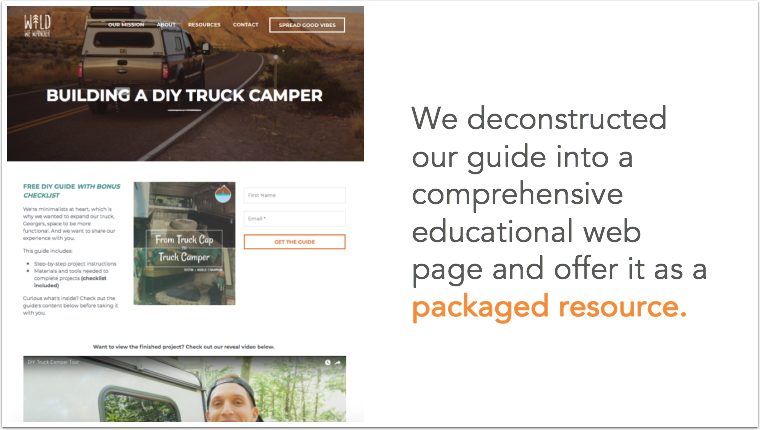
That’s how I solved for the human experience — creating value before trying to extract it. But what about search engines? Did this experiment increase awareness of our content and attract more people to our site? Over the next 12 months, this page received over 16,500 website visits from search engines.

On top of that, we rank number one on Google for the exact contextual term we intended to rank for — “DIY truck camper.”

We were excited about the results and curious; “What other value did we get out of this experiment?”
We found that we ranked for a list of other terms, ones we didn’t even include specifically on the page, like “converted truck camper”.

The reason why that’s important is that search engines like Google are much smarter nowadays. If the content you create provides value and matches the intent of a searcher’s query, then it’s possible you’ll rank for other related terms. In fact, the average
Creating a long-term inbound content strategy like this is like trying to climb a steep mountain.

Imagine this, you’re at the base of this mountain and your goal is to get to the top. But the top of the mountain seems so far away, you can barely see it. You don’t see a clearly defined path and you’ve never climbed a mountain like this before, so the challenge of reaching the summit is a daunting and scary task, to say the least.
But you know what, others before you have trailblazed their climb toward reaching the summit. And if they can do it, then you sure as hell can.
When climbing any mountain, whether it’s literal or metaphorical, focus on the steps not how steep it is.
Focusing on the steps will make your climb more manageable and less overwhelming.
To help us understand this better, let’s refer to chess grandmaster, Maurice Ashley. Ashley gave a TED talk titled, Working Backwards to Solve Problems. In his TED talk, Ashley talks about the idea of retrograde analysis.
Retrograde analysis is
So you may be asking yourself, “that’s great for chess players, but how’s this going to help me build a long-term inbound content strategy?”
I want you to take five seconds and read this sentence.

Notice anything? It’s possible the first time you read this sentence your mind skipped the second “is”. But, if you read the sentence backward, you would’ve noticed the “is” immediately.
So, not only does working backward help solve problems, but it prevents them from happening in the first place. Preventing problems from happening in the first place is an important concept for an inbound strategist to master because it could mean the difference between the success or failure of the projects you’re working on and held accountable for.
An inbound strategist can circumvent their issues and roadblocks by reverse engineering their content goals.
Reverse engineering content is the process of working backward to identify a series of steps needed to launch a successful content initiative.
In order to create a successful long-term inbound content strategy, you need to have a vision. Having a vision of what success looks like gives you the opportunity to reverse engineer your plan down to a series of campaign initiatives.
Let’s take a look at an example of a brand that has been creating a meaningful learning experience for their audience for over a decade. The brand is Moz, a company that specializes in building tools that make you a more effective inbound marketer, SEOer, and link builder. They created an educational resource page for one of their key broad topics, “content marketing.”
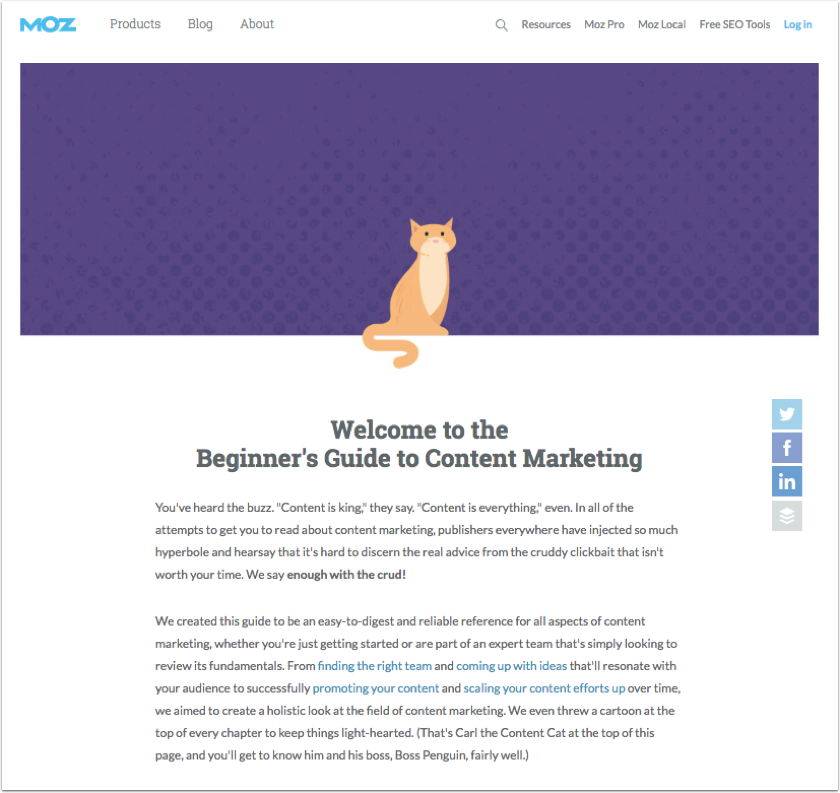
This resource page serves as the hub for nine long-form, in-depth educational website pages that bring context to content marketing, like "content promotion".

The goal is to rank high on the first page of Google for each contextual term. Notice how the “content promotion” educational page ranks number one on Google for its contextual term.

Because this page, as well as the other eight pages a part of the cluster, offers a table of contents which links all the pages together, they all get a boost in authority from this page’s performance.
Creating a long-term inbound content strategy like this could feel like trying to climb a steep mountain. So, let’s dissect this example by reverse engineering how your brand can create a plan like this in three steps.
Broad topics live at the summit of the mountain. The reason they live at the top is to create alignment for your ongoing content efforts — if your initiatives don’t align with these broad topics, then you need to question why you’re spending time on them.

Your broad topics should have high monthly search volume and are generally one to three words in length. Ideally, you’d love for your business to rank for each broad topic, but often times it’s a stretch unless you have a strategy to do so (which we’ll get into further in the next section).
When doing research on your broad topics, consider going directly to the source to learn more, Google. You can use a free tool like the Keywords Everywhere plugin to determine monthly search volume.
For example, when using the Keywords Everywhere plugin, notice how Moz’s broad topic, “content marketing,” has 90,500 monthly searches. This is a great example of a broad topic with high monthly search volume that can be dug into and explained at a deeper level.

There are two places to start when identifying broad topics for your brand:
Start with your audience: What are their search habits? What questions do they have? What are they looking to learn more about?
Make sure the broad topics you choose to create education around align with and support the products and services your business offers.
Remember, the goal is to identify a broad topic with high monthly search volume. That’s an important part of the formula because you want to make sure there’s enough monthly search volume to justify your content creation efforts.
Let’s move on to the next step.
A broad topic casts a wide net because there’s no context to what the searcher might be looking for. When you support a broad topic with
Contextual terms are about halfway up the mountain you’re trying to climb. In contrast with the broad topic you chose, your goal is to actually rank on Google for these terms because they’re more within reach. Ranking for your contextual terms first gives you a fighting chance of achieving visibility for your broad topic. But it’s about climbing the mountain in stages.

Contextual terms are generally two to six words in length.
You can perform research on Google to find potential contextual terms with Google’s autocomplete and related searches function.

Another option is doing research on the first page of Google.

You can get a lot of ideas for contextual terms just by clicking through the listings that Google decided to rank and research the content. Is it up to date? What’s the searchers intent? How could it be improved?

And once you finish researching a web page, click the back button to go back to the search engine result page and check out Google’s “people also search for” text box. These are specific queries that people used before clicking on the listing you researched.
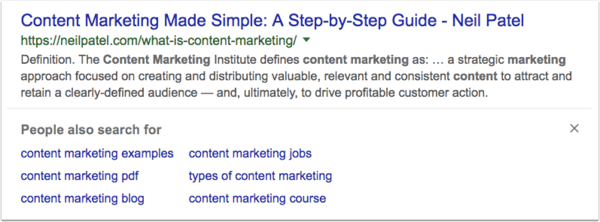
When performing research on Google with the Keywords Everywhere plugin, take the time to exhaust your options. For example, notice how “content marketing promotion” has 30 monthly searches.

But when you dig in deeper you see that “content promotion” is a similar contextual term, but offers more monthly searches at 3,400.

Keep in mind, the more monthly searches a term has, the harder it will be to rank for.
When identifying contextual terms, don’t over think the research process so much so that it keeps you from getting started. Because remember, the average
Here’s a list of contextualized terms Moz identified in support of their broad topic, “content marketing”. Put these contextualized terms together and you have a comprehensive overview of their broad topic. If someone was looking to become an effective content marketer, then this would be a helpful starting place.

I want to say this one more time before moving on, the goal with each contextual term is to create a comprehensive educational website page with the intention of getting it ranking on the first page of Google.

Going back to our mountain analogy, Moz has “content marketing” at the top. This is one of their key broad topics with high monthly search volume that they’re using to align a long-term inbound content strategy. The plan is made up of multiple contextualized terms, like content promotion. Identifying these contextualized terms is important because they’re semantically related to ”content marketing,” but aren’t nearly as difficult to rank for (or as steep of a climb).

Now that you’ve outlined the high-level requirements for your long-term inbound content strategy, think about a resource for your broad topic that ties all of the pages together in a helpful, practical way.
Here’s how you do it. You’re the subject matter expert when it comes to what you’re trying to teach your audience. And your audience wants to learn, apply, and transform, but they won’t if they’re overwhelmed. It’s up to you to show them how to do it in bite-sized chunks.
Imagine what an effective practical offer looks like, then reverse engineer it with prescriptive exercises needed to complete that transformation. For example, my first book, Inbound Content, teaches how to become an effective content marketer. But to actually help transform into one, there are bite-sized activities after each chapter for the reader to complete and by the end of the book equal a content marketing transformation.

It’s like a puzzle; Each practical exercise is a puzzle piece which connects to and builds on the previous exercises to form a larger picture. Sample exercises in Inbound Content include generating ideas for a piece of content...

And using those ideas to create a series of blog posts...

To repurposing those blogs into a downloadable offer...

Which can be used to build a comprehensive educational website page.

Skipping one of these steps along the way could confuse or overwhelm the reader, which could lead to them not completing their content marketing transformation.
When creating a long-form practical offer, like Inbound Content, you can create it one puzzle piece at a time and grow into it. If you try to do it all at once, then it could be overwhelming and feel like a nearly impossible feat. That's what I used to think until now...
For example, before I published Inbound Content, I created HubSpot Academy’s Content Marketing Workbook, which is the supplemental practical resource for their Content Marketing Certification Course.

Each section of the workbook offers one to two paragraphs of text with practical exercises and recommended readings from other sites.
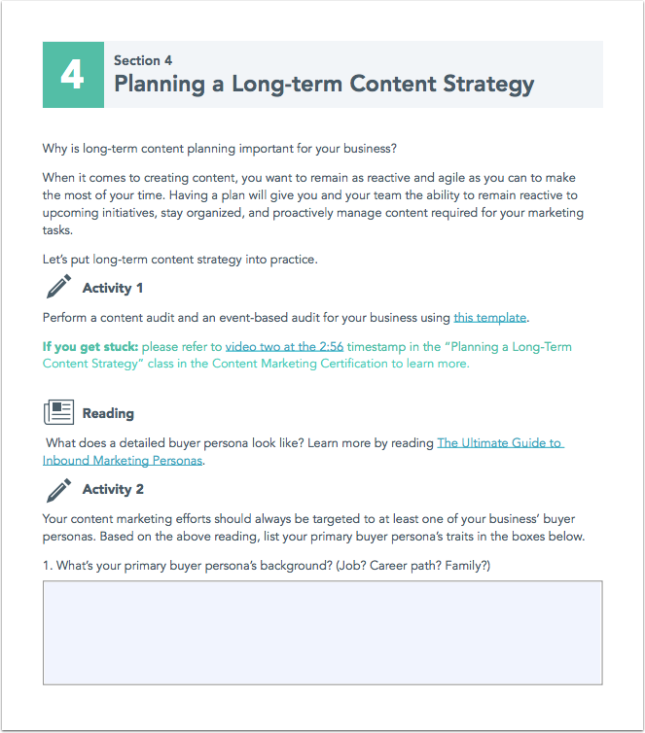
This is not nearly as robust or practical as Inbound Content, which published 15 months later. It took me time to update and expand the content I was working on, and I wanted to give it the care and attention it deserved. Create value in the near term, but keep your long-term goals in mind and make consistent progress towards them.
Let's recap what you just learned to help you towards your journey . to creating a successful inbound marketing strategy :
You learned what broad topic is and how to identify one for your business.
You learned what a contextual term is a
And you learned how to outline a practical offer that ties everything together to create the ultimate transformational experience for your audience. Remember, this will most likely evolve over time, but you can launch this in the near term as a lightweight practical worksheet that can be updated and expanded once your entire topic cluster is complete.
At this point, you may be asking yourself, "this is all great, but what should I do next to create my business's inbound marketing strategy?"
I'm glad you asked. Read on in the section below...
My purpose is to help you and your business navigate your inbound content strategy transformation. I’m on a mission to help the world become better storytellers and more effective content marketers. And that’s exactly why I created
The inspiration for Inbound Strategy Camp came from a workshop roadshow I went on with HubSpot Academy. We traveled over 50,000 miles in two years and hosted a series of workshops that taught people a framework for effectively creating and structuring their content online to be found, consumed, and shared by their ideal audience.
I received feedback from those attending my workshops. Actually seeing the impact I was making on others and witnessing the growth they were experiencing inspired and motivated me to take this content and experience to the next level.
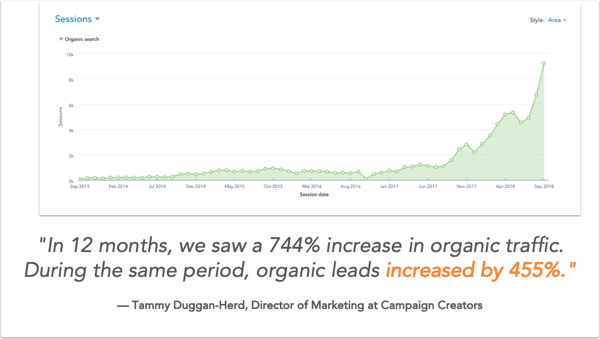
Click here to see what alumni have to say about their experience.
Inbound Strategy Camp brings together all of the research, experiments, and insights I’ve learned over the past several years into a 30-minute video training with a step-by-step practical guide.

If you're ready to start your inbound content strategy transformation, then click the button below.

On June 30, 2017, my wife, Ariele, and I completed a 10,700-mile trek. We traveled across the United States in 100 days in our Airstream and DIYed truck camper.

The purpose of this 100-day journey was to educate and inspire people to create more effective inbound content for their businesses. I did this by hosting a series of content strategy-themed workshops.
Smart content strategies from @JustinRChampion at @SLCHUG workshop. @HubSpotAcademy #unboundinbounder @Pivotslc #avmarketing pic.twitter.com/vIy7PBptp1
— Susan LaPoint (@SusanLaPoint) June 1, 2017
Little did I know that I, too, would be educated and inspired to create something special: a resource that teaches people how to become effective content marketers with activities that actually help them transform into one.
Feedback from my workshop tour inspired and motivated me to write the manuscript for Inbound Content in six weeks while we traveled 6,714 miles from Southern California to the Blue Ridge Mountains in Virginia.

Inbound Content offers the techniques and strategies needed to create content that will attract the right people, convert those people into leads, and help engage them to become customers. This dynamic guide details the proven processes that highlight the creation and distribution of valuable, relevant, and consistent content.
"Justin Champion's new book is a comprehensive overview of content marketing and a much-needed gift to a field short on actionable guidance that both teaches and inspires. Through engaging storytelling he arms his readers with frameworks and exercises, illustrated with real-life examples."
— Anke Audenaert, digital marketing nanodegree lead at Udacity and adjunct professor of marketing at the UCLA Anderson School of Management
This book is the pre-requisite practical resource to Inbound Strategy Camp's free online training series.